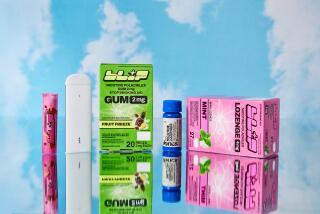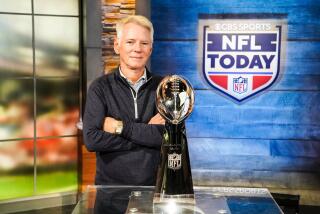Anti-Snore Aids Score Big in Super Bowl of Marketing
- Share via
When National Football League stars Herschel Walker and Jerry Rice started scoring touchdowns with an adhesive strip strapped across their nose, they gave CNS Inc. an advertising boost that money couldn’t buy.
The football heroes were wearing the company’s Breathe Right Nasal Strips, which they said forced their nostrils wider, allowing them to get more air when breathing. Now CNS hopes it can garner the same sort of unsolicited testimonial for its new offering, an anti-sneeze product. If it works, spring fever won’t pack such a punch.
“We’ve got a new gel ready for 1997 that, rubbed on the tip of the nose, filters out pollen, mold spores and dust,” said Kirk Hogdon, marketing manager of CNS, based in Bloomington, Minn. “And we’re planning to put ourselves in the path of luck and help it strike again.”
It certainly struck with gale force for Breathe Right, which is also marketed as a means to help people snore less. The company gave the strips away to NFL trainers while pressuring stores to stock its adhesive strips, which cost between $4 and $5 for 10 strips. Walker and Rice scored on the field, and CNS scored at the cash register.
Invented in 1987, Breathe Right strips were licensed by CNS in 1992 and cleared to market by the Food and Drug Administration in October 1993. Sales for 1994 were $2.8 million, jumping to $48.6 million last year. This year, analysts expect sales of $100 million and more than $120 million next year. The product is distributed internationally by 3M and last year was the top-selling cold/allergy/sinus product in U.S. drug stores.
A turning point was Super Bowl XXIX in 1995, when players wearing Breathe Right strips scored eight of 10 touchdowns.
“After the game, three out of every four adults had heard of Breathe Right, compared to one in four a year earlier,” Hogdon said. More heard about them the following month after Rush Limbaugh’s wife, Marta, tried the strip after nasal surgery and the commentator raved about it on his radio and TV shows.
“Things snowballed and we tried to manage it,” Hogdon said. That meant building on the free publicity with paid advertising. Now the strip is seen on the noses of Marlene Dietrich, Alfred Hitchcock, Mona Lisa, the Statue of Liberty and Stan Laurel in print ads created by the Sietsema, Engel & Partners agency in Minneapolis. Television commercials that began this year show congestion as a major problem on the “annoyance meter.”
“Awareness is something you rent; you don’t own it,” Hogdon said. “That’s why Coke and Pepsi spend millions every year.”
CNS plans to spend $10 million on marketing this year, including an October sweepstakes to win tickets to the Super Bowl and meet Breathe Right pitchman Jerry Rice. A holiday promotion presents Breathe Right as “stocking stuffers for the snorer in your life.” British Airways distributes them in a complimentary amenities kit to first-class passengers.
Now that the FDA has approved Breathe Right as an anti-snoring device, it has broadened its benefits from the playing field to the pillow. The FDA also has approved it to help relieve nasal congestion caused by a cold or allergies.
With two out of three Americans suffering from nasal congestion regularly and 40 to 60 million having debilitating allergies, the product is game for anyone with a nose. So far, Breathe Right comes in three sizes but only one color, another marketing ploy to keep the Band Aid-like product highly visible.
The company is also testing an appetite suppressant and TheraPatch, a 2-by-3-inch alternative to pain-relief products such as Ben Gay.
CNS has consistently aimed at three major markets: snoring, cough/cold and sports/exercise. Snoring has the greatest potential: 90 million Americans over age 18 snore, and 37 million do it habitually.
Most chronic snorers are middle-aged men, but it’s women who suffer. Some 59% say they’ve been awakened by someone else’s snoring--and 65% stayed awake.
Sawing wood surpasses hogging the covers or bed, cold feet or hands, tossing and turning among boudoir bothers and is at least six times more irksome than other irritations like morning breath or flatulence. A survey conducted by National Family Opinion Research found that 62% of those who share a household with a snorer were either annoyed, frustrated or angry about it; only 8% were sympathetic. More than 14% have moved to different rooms.
There’s some dispute as to whether Breathe Right works. Neil Feldman, medical director of the St. Petersburg Sleep Disorder Center, dismisses Breathe Right as a lot of “hype and hooey.” But a study in the June 1994 ENT Journal says the strips do cut mild snoring, and CNS chief Dr. Dan Cohen said clinical trials found they helped 70% of those with nasal congestion. Now the question is, can the company that feathered its bed with a snore-ender make hay by ridding the world of hay fever?
More to Read
Go beyond the scoreboard
Get the latest on L.A.'s teams in the daily Sports Report newsletter.
You may occasionally receive promotional content from the Los Angeles Times.










